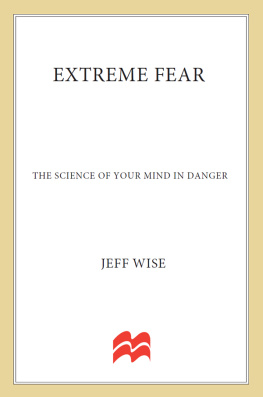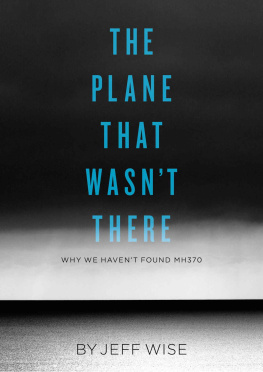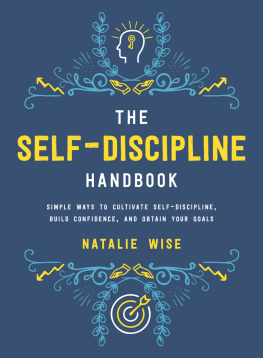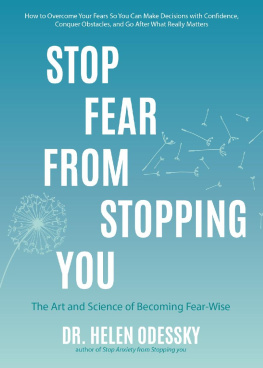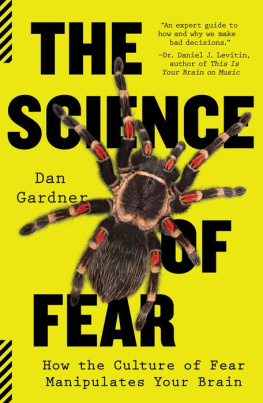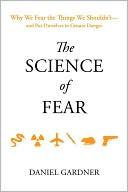EXTREME FEAR
THE SCIENCE OF YOUR MIND IN DANGER
Jeff Wise

The author and publisher have provided this e-book to you for your personal use only. You may not make this e-book publicly available in any way. Copyright infringement is against the law. If you believe the copy of this e-book you are reading infringes on the authors copyright, please notify the publisher at: us.macmillanusa.com/piracy.
EXTREME FEAR
Copyright Jeff Wise, 2009.
All rights reserved.
For information, address St. Martins Press, 175 Fifth Avenue, New York, N.Y. 10010.
First published in 2009 by
PALGRAVE MACMILLAN
in the United Statesa division of St. Martins Press LLC, 175 Fifth Avenue, New York, NY 10010.
ISBN: 9780230614390
Our eBooks may be purchased in bulk for promotional, educational, or business use. Please contact the Macmillan Corporate and Premium Sales Department at 1-800-221-7945, ext. 5442, or by e-mail at .
Library of Congress Cataloging-in-Publication Data
Wise, Jeff.
Extreme fear : the science of your mind in danger / Jeff Wise.
p. cm.
Includes bibliographical references and index.
ISBN 9780230614390
1. Fear. 2. Neuropsychology. I. Title.
BF575.F2W565 2009
152.46dc22 2009018929
A catalogue record of the book is available from the British Library.
Design by Newgen Imaging Systems (P) Ltd., Chennai, India.
First edition: December 2009
10 9 8 7 6 5 4 3 2 1
Printed in the United States of America.
To Sandra and to Rem, our joy and terror
ACKNOWLEDGMENTS
I OWE A DEBT of gratitude to my agent, David Kuhn, whose persistence was essential in bringing this project to fruition; and also to my editor, Luba Ostashevsky, who with skill and enthusiasm helped me take the manuscript to a level beyond what I could have achieved on my own.
I would also like to thank the magazine editors who worked with me on fear-related articles as I honed my understanding of the topic: Kent Black at Outsides GO, Chris Raymond at Details, and David Dunbar at Popular Mechanics.
Finally, I could never have written a word of this book without the support of my wife, Sandra Garcia, who in addition to emotional and intellectual support kept our newborn baby pacified while I sweated under deadline.
INTRODUCTION
THE MYSTERY OF FEAR
ON JUNE 3, 1970, shortly before noon, a British pilot named Neil Williams strapped himself into the harness of his blue-and-white Zlin Akrobat, a rugged but nimble single-engine airplane built in Czechoslovakia. The World Aerobatic Championship was coming up, and Williams planned to prepare himself by running through the sequence of maneuvers that hed be flying in competition.
With a lantern jaw, deep-set eyes, and shock of dark hair swept back from a high forehead, Williams looked every bit a casting directors idea of a daredevil pilotand in his case, looks did not deceive. Williams was a veteran flyer with a vast and varied store of experience under his belt. In the course of his career he had flown more than 150 different kinds of airplanes and accumulated more than six thousand hours in flight time. A retired Royal Air Force test pilot, and four-time winner of the UK aerobatic championships, he was, at thirty-six, already regarded as one of the greatest all-around pilots that Britain had ever produced. But his skills had never been tested as they were about to be.
Rafts of fair-weather clouds drifted over the Royal Air Force base at Hullavington, England, as Williams lined up on the runway, opened the throttle, and roared into the air at full power. The wind aloft was gentle, and as Williams climbed he noted with satisfaction that there was no detectable turbulencethat meant hed be able to carve his maneuvers all the more precisely.
Williams ran his sequence twice through without incident, then brought the Zlin back to level flight and prepared to practice his routine one final time. After only a few minutes in the air, he was already near his limit for fatigue. Competitive aerobatics is a uniquely demanding undertaking. As a mental discipline, it requires exacting attention to detail, the ability to think quickly and three-dimensionally, and the ability to maintain ones poise while rapidly moving through maneuvers that turn the plane upside down, cause it to fall backward, or spin like a top. As a physical discipline, it requires grit and superb fitness as the airplanes abrupt changes of direction slam the pilot from one side of the cockpit to the other, with centrifugal forces at times pressing on his body with nine times its actual weight and at other times leaving him hanging upside-down from his harness straps. A four-minute aerobatic routine is enough to leave a pilot drained and soaked in sweat.
Midway through the third run-through of his routine, Williams was coming over the top of a loop, a high arcing figure in which his plane carved through the air like a high fly ball. As it reached the top, Williams was upside-down in his seat, the checkered farmland of southwest England arrayed above his head, the cloud-dappled sky under his seat. The plane continued its arc downward past its apex, and the horizon sank toward the bottom of his windscreen until all he could see in front of him was ground. His descent grew steeper and steeper until he was staring straight down.
Barreling earthward through fifteen hundred feet, Williams hauled the stick toward his chest in order to pull the Zlin back to level flight. He clenched his abdominal muscles in anticipation of the resulting g-forces, as gravity combined with the centrifugal force of the planes curving path would press him into his seat with five times his normal weight. Only by grunting and clenching his leg and stomach muscles could he prevent the blood from rushing out of his head and causing him to black out.
The plane was just coming level with the ground, one thousand feet up, when
BANG!
A jolt shook the airplane. The Zlin started rolling leftall except the left wing, which stayed oddly level with the horizon. Williams instantly intuited what had happened: The force of the pull-out had likely broken the internal spar that gave the wing most of its strength. If that were the case, then the whole wing was about to fall off. He pushed the stick all the way to the right, but the plane kept rolling left. The ground was just 300 feet below and rising fast.
For most pilots, that would have been the end. But in the few seconds he had left before his plane cratered, Williams had an insight. He remembered the story of a Bulgarian pilot who had suffered a malfunction in a similar Zlin model years before. The circumstances in that case had been differentthe Bulgarian had been flying inverted when a bolt failure in one of the wings had caused the plane to unexpectedly flip right-side up. But a detail of the story stuck out: Once the Bulgarians plane was right-side up, the wing had snapped back into place. Maybe Williams situation was analogous, but reversed. If he went from right-side up to upside down, his wing might snap back in place, too.
In less time than it takes to form a complete thought, Williams threw the stick hard to the left until the Zlin was fully inverted, then pushed the stick forward. His face swelled and turned red as gravity and centrifugal force drained blood from his body into his head.
WHUMP!
With a satisfying thud the wing settled backed into place. By now Williams was almost in the treetops, and for a moment he was sure he was going to crash. Then the plane began to climb.

